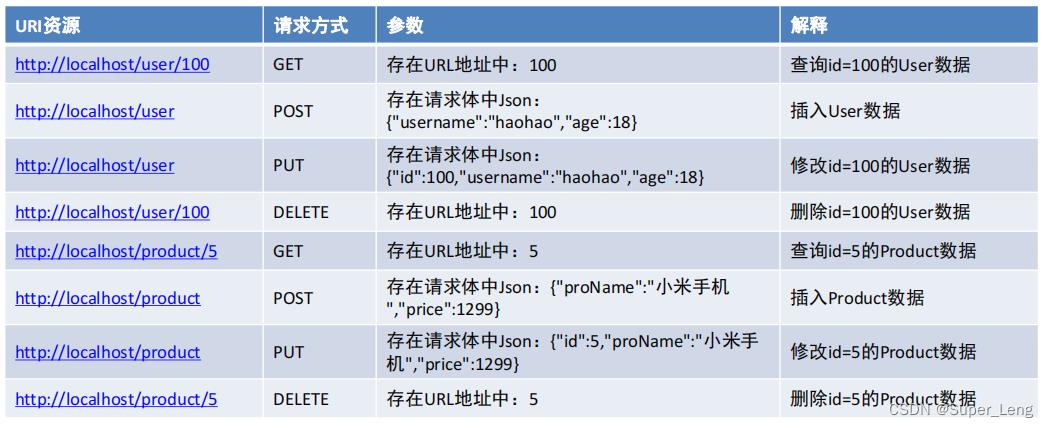求助springmvc rest路径映射问题
Posted
tags:
篇首语:本文由小常识网(cha138.com)小编为大家整理,主要介绍了求助springmvc rest路径映射问题相关的知识,希望对你有一定的参考价值。
参考技术A <bean class="org.springframework.web.servlet.mvc.method.annotation.RequestMappingHandlerMapping"><property name="alwaysUseFullPath" value="true"></property>
</bean>
这样也是可以的。 参考技术B 设置的urloattern 是.aspx 所以在requestMapping中应该配置value="service/id.aspx"; 要符合restful风格,应该配置urlpattern 为*
SpringMVC的请求处理
文章目录
一、请求映射路径的配置
配置映射路径,映射器处理器才能找到Controller的方法资源,目前主流映射路径配置方式就是@RequestMapping

@RequestMapping注解,主要使用在控制器的方法上,用于标识客户端访问资源路径,常用的属性有value、path、method、headers、params等。当@RequestMapping只有一个访问路径需要指定时,使用value属性、path属性或省略value和path,当有多个属性时,value和path不能省略
@RequestMapping(value = "/show")//使用value属性指定一个访问路径
public String show()
@RequestMapping(value = "/show","/haohao","/abc")//使用value属性指定多个访问路径
public String show()
@RequestMapping(path = "/show")//使用path属性指定一个访问路径
public String show()
@RequestMapping(path = "/show","/haohao","/abc")//使用path属性指定多个访问路径
public String show()
@RequestMapping("/show")//如果只设置访问路径时,value和path可以省略
public String show()
@RequestMapping("/show","/haohao","/abc")
public String show()
当@RequestMapping 需要限定访问方式时,可以通过method属性设置
//请求地址是/show,且请求方式必须是POST才能匹配成功
@RequestMapping(value = "/show",method = RequestMethod.POST)
public String show()
method的属性值是一个枚举类型,源码如下:
public enum RequestMethod
GET,
HEAD,
POST,
PUT,
PATCH,
DELETE,
OPTIONS,
TRACE;
private RequestMethod()
@GetMapping,当请求方式是GET时,我们可以使用@GetMapping替代@RequestMapping
@GetMapping("/show")
public String show()
@PostMapping,当请求方式是POST时,我们可以使用@PostMapping替代@RequestMapping
@PostMapping("/show")
public String show()
@RequestMapping 在类上使用,@RequestMapping 、@GetMapping、@PostMapping还可以使用在Controller类上,使用在类上后,该类所有方法都共用该@RequestMapping设置的属性,访问路径则为类上的映射地址+方法上的映射地址,例如:
@Controller
@RequestMapping("/xxx")
public class UserController implements ApplicationContextAware, ServletContextAware
@GetMapping("/aaa")
public ModelAndView aaa(HttpServletResponse response) throws IOException, ModelAndViewDefiningException
return null;
此时的访问路径为:/xxx/aaa
二、请求数据的接收
1. 接收普通请求数据
接收普通请求数据,当客户端提交的数据是普通键值对形式时,直接使用同名形参接收即可
username=haohao&age=35
@GetMapping("/show")
public String show(String username, int age)
System.out.println(username+"=="+age);
return "/index.jsp";
接收普通请求数据,当请求参数的名称与方法参数名不一致时,可以使用@RequestParam注解进行标注
username=haohao&age=35
@GetMapping("/show")
public String show(@RequestParam(name = "username",required = true) String name, int age)
System.out.println(name+"=="+age);
return "/index.jsp";
2. 接收数组或集合数据
接收数组或集合数据,客户端传递多个同名参数时,可以使用数组接收
hobbies=eat&hobbies=sleep
@GetMapping("/show")
public String show(String[] hobbies)
for (String hobby : hobbies)
System.out.println(hobby);
return "/index.jsp";
客户端传递多个同名参数时,也可以使用单列集合接收,但是需要使用@RequestParam告知框架传递的参数是要同名设置的,不是对象属性设置的
@GetMapping("/show")
public String show(@RequestParam List<String> hobbies)
for (String hobby : hobbies)
System.out.println(hobby);
return "/index.jsp";
接收数组或集合数据,客户端传递多个不同命参数时,也可以使用Map<String,Object> 进行接收,同样需要用@RequestParam 进行修饰
username=haohao&age=18
@PostMapping("/show")
public String show(@RequestParam Map<String,Object> params)
params.forEach((key,value)->
System.out.println(key+"=="+value);
);
return "/index.jsp";
3. 接收实体JavaBean属性数据
接收实体JavaBean属性数据,单个JavaBean数据:提交的参数名称只要与Java的属性名一致,就可以进行自动封装
username=haohao&age=35&hobbies=eat&hobbies=sleep
public class User
private String username;
private Integer age;
private String[] hobbies;
private Date birthday;
private Address address;
//... 省略get和set方法 ...
@GetMapping("/show")
public String show(User user)
System.out.println(user);
return "/index.jsp";
接收实体JavaBean属性数据,嵌套JavaBean数据:提交的参数名称用 . 去描述嵌套对象的属性关系即可
username=haohao&address.city=tianjin&address.area=jinghai
public class Address
private String city;
private String area;
//... 省略get和set方法 ...
// http://localhost/param6?username=haohao&address.city=tianjin&address.area=jinghai
@GetMapping("/param6")
public String param6(User user)
System.out.println(user);
return "/index.jsp";
4. 接收Json数据格式数据
接收Json数据格式数据,Json数据都是以请求体的方式提交的,且不是原始的键值对格式的,所以我们要使用@RequestBody注解整体接收该数据。
"username":"haohao",
"age":18,
"hobbies":["eat","sleep"],
"birthday":"1986-01-01",
"address":
"city":"tj",
"area":"binhai"
@PostMapping("/show6")
public String show6(@RequestBody String body)
System.out.println(body);
return "/index.jsp";
使用Json工具( jackson )将Json格式的字符串转化为JavaBean进行操作
<dependency>
<groupId>com.fasterxml.jackson.core</groupId>
<artifactId>jackson-databind</artifactId>
<version>2.9.0</version>
</dependency
@PostMapping("/show")
public String show(@RequestBody String body) throws IOException
System.out.println(body);
// 获得ObjectMapper
ObjectMapper objectMapper = new ObjectMapper();
// 将json格式字符串转化成指定的User
User user = objectMapper.readValue(body, User.class);
System.out.println(user);
return "/index.jsp";
配置RequestMappingHandlerAdapter,指定消息转换器,就不用手动转换json格式字符串了
<bean class="org.springframework.web.servlet.mvc.method.annotation.RequestMappingHandlerAdapter">
<property name="messageConverters">
<list>
<bean class="org.springframework.http.converter.json.MappingJackson2HttpMessageConverter"/>
</list>
</property>
</bean>
@PostMapping("/show")
public String show(@RequestBody User user)
System.out.println(user);
return "/index.jsp";
接收Json数据格式数据,使用Map接收json格式字符串
@PostMapping("/show")
public String show(@RequestBody Map map)
System.out.println(map);
return "/index.jsp";
5. 接收Restful风格数据
什么是Rest风格?
Rest(Representational State Transfer)表象化状态转变(表述性状态转变),在2000年被提出,基于HTTP、URI、xml、JSON等标准和协议,支持轻量级、跨平台、跨语言的架构设计。是Web服务的一种新网络应用程序的设计风格和开发方式。
Restful风格的请求,常见的规则有如下三点:
① 用URI表示某个模块资源,资源名称为名词

② 用请求方式表示模块具体业务动作
例如:GET表示查询、POST表示插入、PUT表示更新、DELETE表示删除

③ 用HTTP响应状态码表示结果
,国内常用的响应包括三部分:状态码、状态信息、响应数据
"code":200,
"message":"成功",
"data":
"username":"haohao",
"age":18
"code":300,
"message":"执行错误",
"data":"",
接收Restful风格数据,Restful请求数据一般会在URL地址上携带,可以使用注解 @PathVariable(占位符参数名称)
http://localhost/user/100
@PostMapping("/user/id")
public String findUserById(@PathVariable("id") Integer id)
System.out.println(id);
return "/index.jsp";
请求URL资源地址包含多个参数情况
http://localhost/user/haohao/18
@PostMapping("/user/username/age")
public String findUserByUsernameAndAge(@PathVariable("username") String username, @PathVariable("age") Integer age)
System.out.println(username+"=="+age);
return "/index.jsp";
接收文件上传的数据,文件上传的表单需要一定的要求,如下:
⚫ 表单的提交方式必须是POST
⚫ 表单的enctype属性必须是multipart/form-data
⚫ 文件上传项需要有name属性
<form action="" enctype="multipart/form-data" method="post" >
<input type="file" name="myFile">
</form>
服务器端,由于映射器适配器需要文件上传解析器,而该解析器默认未被注册,所以需要手动注册
<!--配置文件上传解析器,注意:id的名字是固定写法,id必须是multipartResolver,因为Spring容器是根据id="multipartResolver"获取的CommonsMultipartResolver-->
<bean id="multipartResolver" class="org.springframework.web.multipart.commons.CommonsMultipartResolver">
<property name="defaultEncoding" value="UTF-8"/><!--文件的编码格式 默认是ISO8859-1-->
<property name="maxUploadSizePerFile" value="1048576"/><!--上传的每个文件限制的大小 单位字节-->
<property name="maxUploadSize" value="3145728"/><!--上传文件的总大小-->
<property name="maxInMemorySize" value="1048576"/><!--上传文件的缓存大小-->
</bean>
而CommonsMultipartResolver底层使用的Apache的是Common-fileuplad等工具API进行的文件上传,所以必须导入以下依赖
<dependency>
<groupId>commons-fileupload</groupId>
<artifactId>commons-fileupload</artifactId>
<version>1.4</version>
</dependency>
使用MultipartFile类型接收上传文件
@PostMapping("/fileUpload")
public String fileUpload(@RequestBody MultipartFile myFile) throws IOException
System.out.println(myFile);
// 获得上传的文件的流对象
InputStream inputStream = myFile.getInputStream();
// 使用commons-io存储到C:\\haohao\\abc.txt位置
FileOutputStream outputStream = new
FileOutputStream("C:\\\\Users\\\\haohao\\\\" + myFile.getOriginalFilename());
IOUtils.copy(inputStream,outputStream);
// 关闭资源
inputStream.close();
outputStream.close();
return "/index.jsp";
接收Http请求头数据,接收指定名称的请求头
@GetMapping("/headers")
public String headers(@RequestHeader("Accept-Encoding") String acceptEncoding)
System.out.println("Accept-Encoding:" + acceptEncoding);
return "/index.jsp";
接收所有的请求头信息
@GetMapping("/headersMap")
public String headersMap(@RequestHeader Map<String,String> map)
map.forEach((k,v)->
System.out.println(k+":"+v);
);
return "/index.jsp";
获得客户端携带的Cookie数据
@GetMapping("/cookies")
public String cookies(@CookieValue(value = "JSESSIONID",defaultValue = "") String jsessionid)
System.out.println(jsessionid);
return "/index.jsp";
获得转发Request域中数据,在进行资源之间转发时,有时需要将一些参数存储到request域中携带给下一个资源
@GetMapping("/request1")
public String request1(HttpServletRequest request)
// 存储数据
request.setAttribute("username","haohao");
return "/request2";
@GetMapping("/request2")
public String request2(@RequestAttribute("username") String username)
System.out.println(username);
return "/index.jsp";
请求参数乱码的解决方案,Spring已经提供好的CharacterEncodingFilter来进行编码过滤
<!--配置全局的编码过滤器-->
<filter>
<filter-name>CharacterEncodingFilter</filter-name>
<filter-class>org.springframework.web.filter.CharacterEncodingFilter</filter-class>
<init-param>
<param-name>encoding</param-name>
<param-value>UTF-8</param-value>
</init-param>
</filter>
<filter-mapping>
<filter-name>CharacterEncodingFilter</filter-name>
<url-pattern>/*</url-pattern>
</filter-mapping>
三、Javaweb常用对象获取
获得Javaweb常见原生对象,有时在我们的Controller方法中需要用到Javaweb的原生对象,例如:Request、Response等,我们只需要将需要的对象以形参的形式写在方法上,SpringMVC框架在调用Controller方法时,会自动传递实参:
@GetMapping("/javawebObject")
public String javawebObject(HttpServletRequest request, HttpServletResponse response, HttpSession session)
System.out.println(request);
System.out.println(response);
System.out.println(sess以上是关于求助springmvc rest路径映射问题的主要内容,如果未能解决你的问题,请参考以下文章